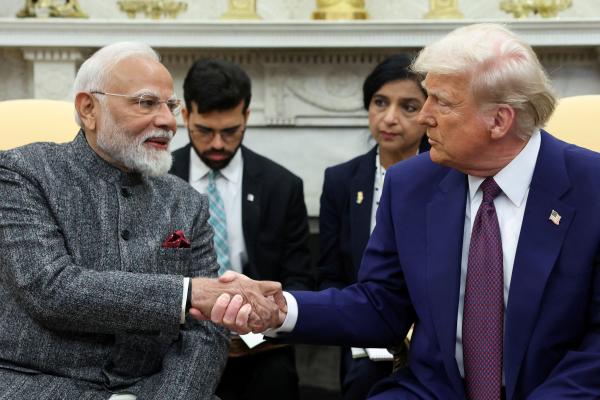WASHINGTON/NEW DELHI, July 30 — United States (US) President Donald Trump imposed a 25 per cent tariff on goods imported from India starting August 1, along with an unspecified penalty for buying Russian weapons and oil, potentially straining relations with the world's most populous democracy.
The US decision on Wednesday singles out India more severely than other major trading partners, and threatens to unravel months of talks between the two countries, undermining a key strategic partner of Washington’s and a counterbalance to China.
"While India is our friend, we have, over the years, done relatively little business with them because their Tariffs are far too high, among the highest in the World, and they have the most strenuous and obnoxious non-monetary Trade Barriers of any Country
"They have always bought a vast majority of their military equipment from Russia, and are Russia’s largest buyer of ENERGY, along with China, at a time when everyone wants Russia to STOP THE KILLING IN UKRAINE — ALL THINGS NOT GOOD!" Trump wrote in a Truth Social post.
The White House has previously warned India about its high average applied tariffs — nearly 39 per cent on agricultural products, with rates climbing to 45 per cent on vegetable oils and around 50 per cent on apples and corn.
Russia continued to be the top oil supplier to India during the first six months of 2025, making up 35 per cent of overall supplies.
The US currently has a US$45.7 billion (RM193.7 billion) trade deficit with India.
The news pushed the Indian rupee down 0.4 per cent to around 87.80 against the US dollar in the non-deliverable forwards market, from its close at 87.42 during market hours. Gift Nifty futures were trading at 24,692 points, down 0.6 per cent.
[caption id="attachment_396862" align="aligncenter" width="1021"] A drone view shows trucks as they transport cargo at the Bayport Container Terminal in Seabrook, Texas, the United States, on April 7, 2025. — Picture by REUTERS[/caption]
A drone view shows trucks as they transport cargo at the Bayport Container Terminal in Seabrook, Texas, the United States, on April 7, 2025. — Picture by REUTERS[/caption]
Contentious issues
"Higher tariffs for India compared to countries it competes with, for exports to the US, are going to be challenging," said PwC India's economic advisory services partner Ranen Banerjee.
India's Commerce Ministry, which is leading the trade talks, did not immediately respond to a request for comment.
US and Indian negotiators had held multiple rounds of discussions to resolve contentious issues, particularly over market access into India for US agricultural and dairy products.
Despite progress in some areas, Indian officials resisted opening the domestic market to imports of wheat, corn, rice and genetically modified soybeans, citing risks to the livelihood of millions of Indian farmers.
In a March report, the US had flagged concerns over India's increasing and burdensome import-quality requirements, among its many barriers to trade.
The new tariffs are expected to impact India’s goods exports to the US, estimated at around US$87 billion (RM368.8 billion) in 2024, including labour-intensive products, including garments, pharmaceuticals, gems and jewellery, and petrochemicals.
India now joins a growing list of countries facing higher tariffs under Trump’s "Liberation Day" trade policy, aimed at reshaping US trade relations by demanding greater reciprocity.
The setback comes despite earlier commitments by Prime Minister Narendra Modi and Trump to conclude the first phase of a trade deal by autumn 2025 and expand bilateral trade to US$500 billion (RM2.11 trillion) by 2030, from US$191 billion (RM809.8 billion) in 2024.
Indian officials have previously indicated that they view the US as a key strategic partner, particularly in counterbalancing China. But they have emphasised the need to preserve policy space on agriculture, data governance, and state subsidies.
[caption id="attachment_397208" align="aligncenter" width="1080"] A China Shipping container is seen at the port of Oakland, as trade tensions escalate over the United States (US) tariffs with China, in Oakland, California, the US, on April 10, 2025. — Picture by REUTERS[/caption]
A China Shipping container is seen at the port of Oakland, as trade tensions escalate over the United States (US) tariffs with China, in Oakland, California, the US, on April 10, 2025. — Picture by REUTERS[/caption]
Hopes for a deal
It was not immediately clear whether the announcement was a negotiating tactic. While Trump railed against Japan in a June 30 Truth Social post and said there would likely be no deal with the North Asian nation, a deal was agreed on July 22.
An Indian government official told Reuters that New Delhi continued to remain engaged with the US to seal an agreement.
Economists similarly remained hopeful.
"While the negotiations seem to have broken down, we do not think the trade-deal haggling between the two nations is over yet," said Emkay Global economist Madhavi Arora.
— Reuters
[caption id="attachment_400012" align="aligncenter" width="1439"] A United States (US) flag flutters near Chinese shipping containers at the Port of Los Angeles, in San Pedro, California, the US, on May 1, 2025. — Picture by REUTERS[/caption]
A United States (US) flag flutters near Chinese shipping containers at the Port of Los Angeles, in San Pedro, California, the US, on May 1, 2025. — Picture by REUTERS[/caption]




